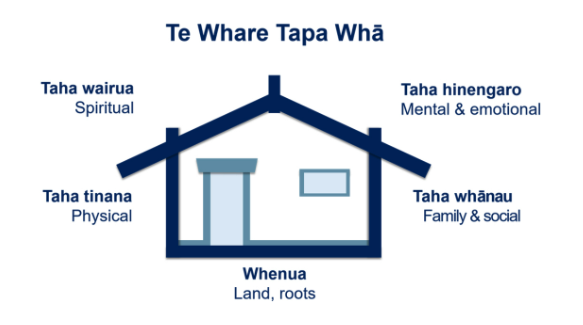Cultural Blog - Introducing Te Whare Tapa Whā
Learning Objectives
By the end of this exploration you should have:
- The ability to create a holistic well-being plan incorporating the different aspects of Te Whare Tapa Whā added to your current learning plan
Summary
We do this to become more aware of our physical, mental, spiritual and family well-being.
Time box
| Activity | Time |
|---|---|
| Reading | 30 minutes |
| Creating plan | 60 minutes |
About
Te Whare Tapa Whā is a model of the 4 dimensions of wellbeing developed by Tā Mason Durie in 1984 to provide a Māori perspective on health.
The 4 dimensions are:
- taha tinana (physical wellbeing)
- taha hinengaro (mental wellbeing)
- taha wairua (spiritual wellbeing)
- taha whānau (family wellbeing)
With 4 walls, the wharenui is a symbol of these 4 dimensions. The wharenui has connections to the whenua (land, sea, natural world) which forms the foundations for the four dimensions

Figure 1: Te Whare Tapa Whā
Taha Tinana (physical wellbeing)
Taha tinana is your physical wellbeing. It is about how your body grows, feels and moves, and how you care for it.
Nourishing and strengthening your physical wellbeing helps you to cope with the ups and downs and life. Feeling physically well helps you feel mentally well.
Some key things to take care of taha tinana are physical activity, healthy eating, and good sleep hygiene.
Taha Hinengaro (emotional and mental wellbeing)
Taha hinengaro is your mind, heart, conscience, thoughts and feelings. It’s about how you feel, as well as how you communicate and think. Taking care of taha hinengaro is important for everyone, regardless of whether or not you’ve experienced mental illness or distress.
The foods we eat can affect our mental health, physical activity can reduce symptoms of stress and anxiety, and learning how to manage stress before it gets overwhelming are all ways to support taha hinengaro.
Taha Wairua (spiritual wellbeing)
The way people view wairua can be very different. For some, wairua is the capacity for faith or religious beliefs or having a belief in a higher power. For others, wairua is an internal connection to the universe or the sacred. There is no right or wrong way to think of or experience wairua, but it is an important part of your mental wellbeing.
Spiritual wellbeing can be expressed through beliefs, values, traditions and practices that support self-awareness and identity. Taha wairua provides a sense of meaning and purpose as well as experiencing a sense of connectedness to self, whānau, community, nature and the sacred.
Taha Whānau (family wellbeing)
Taha whānau is about who makes you feel like you belong, who you care about and who you share your life with.
Whānau is about extended relationships – it’s not just your immediate relatives, it’s your friends, hoamahi (colleagues), community and the people you care about. Everyone has a place and a role to fulfil within their whānau, and whānau contributes to your individual wellbeing and identity.
Spending time with whānau, doing things for them and getting involved gives you a feeling of purpose, connection and wellbeing. It benefits you and strengthens your whānau. As a core source of strength, support, security and identity, whānau plays a central role in your wellbeing.
Whenua (land)
As the foundation for the other 4 dimensions, the health of the land and the natural environment is strongly connected to your health and wellbeing. You can think about whenua as your place of belonging. For Māori, the whenua is a key part of identity.
Connection to the land and to nature has been shown to improve mental and physical wellbeing.
When was the last time you took a moment to enjoy nature? Not just the bush, mountains or beach but the small, everyday wonders all around us – the rustling of the wind through the trees, the spring flowers or the sound of birds settling for the night. Read our top tips for letting nature in to strengthen your wellbeing. Maybe one of these will be your small step to greater wellbeing through whenua.
Why we use Te Whare Tapa Whā at Dev Academy
Dev Academy has a commitment to Te Tiriti O Waitangi and is working out how to honour and integrate its principles. We all live in Aotearoa and drawing on a wellbeing model grounded in Te Ao Māori makes sense. We teach the whole person at Dev Academy, and this holistic approach is aligned with that.
Task
Create a file named te-whare-tapa-wha.html, add it to your blog, and create a wellbeing plan using Tā Mason Durie’s Te Whare Tapa Whā model.
Some activities support and strengthen more than one of the walls, so feel welcome to include them in more than one place.
| Wall | Activities |
|---|---|
| Taha Tinana (Physical Wellbeing) | e.g. going for a swim before class 2 x a week |
| Taha Whānau (Family Wellbeing) | e.g. having dinner with my family every evening |
| Taha Hinengaro (Emotional and Mental Wellbeing) | e.g. listening to a guided meditation before sleep |
| Taha Wairua (Spiritual Wellbeing) | e.g. praying or making time to express gratitude each day |
| Whenua (Interconnections to the land and environment) | e.g. walking on the grass barefoot once a week |